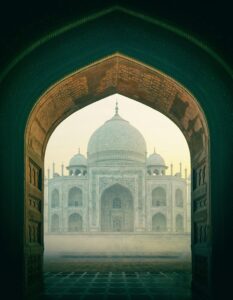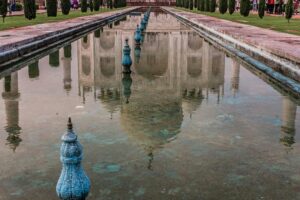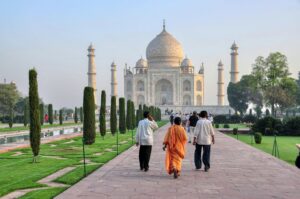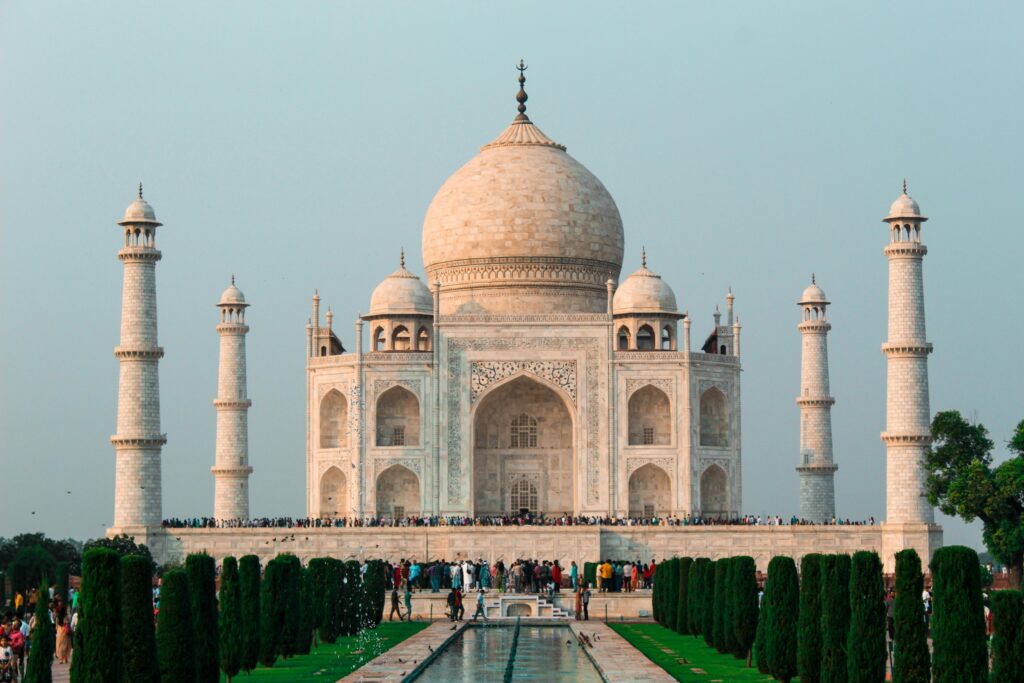The Taj Mahal is often called the “Crown Jewel of India”—an” architectural wonder that presents eternal love. Over a million tourists flock in every year and it has earned its place in the New Seven Wonders of the World. Its design, aesthetic appeal, historical value, as well as its romantic appeal, makes it one of the most acclaimed landmarks of our time.
Historical Background
The Taj Mahal was ordered by Mughal Emperor Shah Jahan in 1632, a tribute to his beloved wife, Mumtaz Mahal, who died while giving birth. He felt a tremendous pain that he could never bear. So, he decided to build an unmatched mausoleum. The Taj Mahal was constructed over a period of 20 years and involved over 20,000 workers, including architects, artisans, and laborers drawn from across India, Persia, and the Ottoman Empire. Ustad Ahmad Lahauri is suspected to be the lead architect, even though the project was a concerted effort by many skilled hands.
It was completed in 1653, and the mausoleum is a magnificent example of the Mughal architecture that attracted elements of Islam, Persia, and Ottoman styles from Indian sources.

Architectural Splendor: The Taj Mahal is the epitome of perfect harmony, made mostly from snow-white Makrana marble with a soft glow. The complex includes several structures: the main mausoleum, a mosque, a guest house, and extremely beautiful gardens on around 42 acres.
The most striking feature of this monument is the main 73-meter dome that seems to easily balance with its four slender minarets. Its finial has motifs from both Islamic and Hindu art and, thus, embodies the concept of unity in diversity.
The Charbagh garden is divided into four parts by water channels, according to Persian landscaping traditions, symbolizing the Islamic concept of paradise. The central water canal reflects the beauty of the Taj Mahal, giving it a more ethereal quality.
Beautiful pieces of calligraphy, especially at the entrance gate, by Amanat Khan in gold, and flowers and foliage inlay with jewels of jasper, jade, turquoise, and lapis lazuli—very delicate—are present examples. Arabic verses of the Quran written at the entrance gates, as well as other parts of the architecture, sanctify the monument.
The Fruitful Labor of Love and Engineering Genius
The construction of the Taj Mahal was an enormous task. Marble was sourced from Rajasthan, and semi-precious stones were imported from as far as China, Tibet, and Sri Lanka. To transport the heavy materials, a fleet of 1,000 elephants was used.
The techniques of engineering used at this time were truly advanced for their era. For example, minarets are slightly tilted outwards so in case of an earthquake they will not collapse onto the main structure, and marble panels are very fine polishings that reflect sunlight and moonlight to create the Taj Mahal’s classic glowing effect.

Cultural and Historical Significance
The Taj Mahal is not just a monument; it stands as a personification of eternal love and devotion. It states the cultural apogee of the Mughal Empire and therefore tries to represent their wealth, sensibilities, and innovations in art and technology.
It was declared a UNESCO World Heritage Site in 1983, recognized as “the jewel of Muslim art in India and one of the universally admired masterpieces of the world’s heritage.”
Modern Challenges and Preservation Efforts
Apart from these challenges, pollution has given the originally gleaming marble a yellowish look; another concern for the foundation is that of the low receding waters of the Yamuna. These issues can be minimized through the activities carried out by the government, such as limiting vehicles’ exhaust close to the monument area and frequent cleaning of the marble to get back its bright looks.

Interesting Facts The Taj Mahal changes its color according to the time of day. It would be pinkish in the morning, dazzling white in the afternoon, and golden under moonlight. It cost an estimated 32 million rupees, amounting to billions of dollars at present-day value. Legends even claimed that he wanted to create a replica of the black marble Taj Mahal on the opposite side of the Yamuna River, but the emperor was deprived of doing so due to his son, Aurangzeb, imprisoning him. Conclusion The Taj Mahal is without a doubt one of the time-honored symbols of love, sacrifice and architectural brilliance. It stands as a monument to the creativity and the commitment of the people who designed it and transcends time as a testimony to the grandeur of the Mughal Empire. The admiration generates profound awe and wonder whether this monument is being contemplated for its historical significance, romantic legacy, or sheer beauty.



